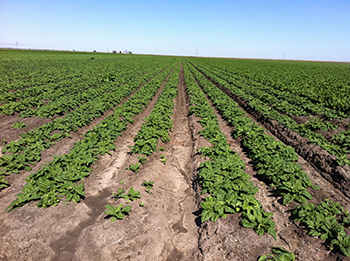Texas A&M researchers help curb rise of contamination in leafy vegetables
The likelihood that a crop of leafy greens will be contaminated by E. coli, an indicator of fecal contamination, before harvest is strongly influenced by both farm management and environmental factors, according to a study spotlighted on the cover of the new issue of the journal Applied and Environmental Microbiology. The work, led by Dr. Renata Ivanek and her lab in the Department of Veterinary Integrative Biosciences (VIBS) at the Texas A&M College of Veterinary Medicine & Biomedical Sciences (CVM), was a collaborative effort between researchers at Texas A&M University, Colorado State University, Texas Tech University, and Texas A&M AgriLife Extension Service.

“This study exemplifies the One Health approach to research, as it highlights the link between animal, human, and environmental health,” said Dr. Eleanor M. Green, the Carl B. King Dean of Veterinary Medicine. “Dr. Ivanek’s work will help the food industry provide safe products by accelerating biomedical research discoveries, enhancing public health efficacy, and expeditiously expanding the scientific knowledge base. We appreciate her excellent work and look forward to future advances in this focused area of food safety.”
Produce safety concerns have been on the rise due to large, multi-state outbreaks of illness attributed to contaminated produce, including spinach and other leafy greens. According to the Centers for Disease Control and Prevention, between 1998 and 2008, of the 68,000 illnesses in foodborne outbreaks assigned to one of the 17 considered food commodities, 13 percent were associated with leafy greens, topped only by poultry at 17 percent. Not only were leafy greens responsible for a significant portion of outbreaks and food product recalls, but the number of illnesses thought to have been caused by leafy greens was on the rise, jumping from 6 percent between 1998 and 1999 to 11 percent between 2006 and 2008.
In this study, the research team cross-referenced environmental data with information from participating farms in multiple test areas. Then, the team determined how three groups of factors-farm management, location, and weather-affect spinach contamination with
E. coli. The team studied spinach samples from 12 farms in Colorado and Texas and compared variables including the local temperature, precipitation, wind speed, soil characteristics, proximity to roads and water bodies, and such farm management practices as the farm workers’ hygiene and manure application practices.
“This study would not have been possible without the help and support of the spinach growers who participated,” Ivanek said. “I hope that our findings will be of use to them and the produce grower industry as a whole.”
Overall, the study found that farm management, location, and weather factors should be considered jointly in developing agricultural methods and interventions that reduce the threat of
E. coli contamination at the pre-harvest level. The odds of spinach contamination decreased to approximately 1 in 17 with implementation of good hygiene practices for farm workers, but they increased to approximately 4 in 1 for every millimeter increase in the average amount of rain in the month before harvest. Furthermore, applying manure fertilizer on the field increased the odds of contamination to approximately 52 in 1.
“Hygiene practices and fertilizers used are relatively easy to change,” Ivanek said. “The challenge, however, will be to use the information about how rainfall affects produce safety into an intervention, or plan, that growers could implement on a daily basis.”
“As consumers, we all depend on producers, food handlers, and food safety regulators to ensure the food we eat is safe, especially foods that are consumed raw,” said Dr. Evelyn Tiffany-Castiglioni, head of the VIBS department. “In order to increase food safety, legislators and food producers need objective evidence about sources of contamination. Dr. Ivanek’s group provides scientific evidence that will inform farm managers about where improvements can be made before harvest to help reduce contamination of spinach with E. coli and pathogens. While it may seem intuitive that farm worker hygiene can be a source of bacterial contamination of raw leafy greens, it was an unproven concept until this careful epidemiologic study from Dr. Ivanek’s group. This is an excellent example of the contributions of veterinary epidemiologists to the improvement of human health and the food industry.”
The study, financed by a grant from the United States Department of Agriculture’s Agriculture and Food Research Initiative (USDA-AFRI) program, was published in the April 2014 issue of Applied and Environmental Microbiology. “This research is an excellent example of colleagues from various disciplines working synergistically to solve universal health and well-being issues,” said Dr. Mike Chaddock, assistant dean for One Health and strategic initiatives at the CVM.


